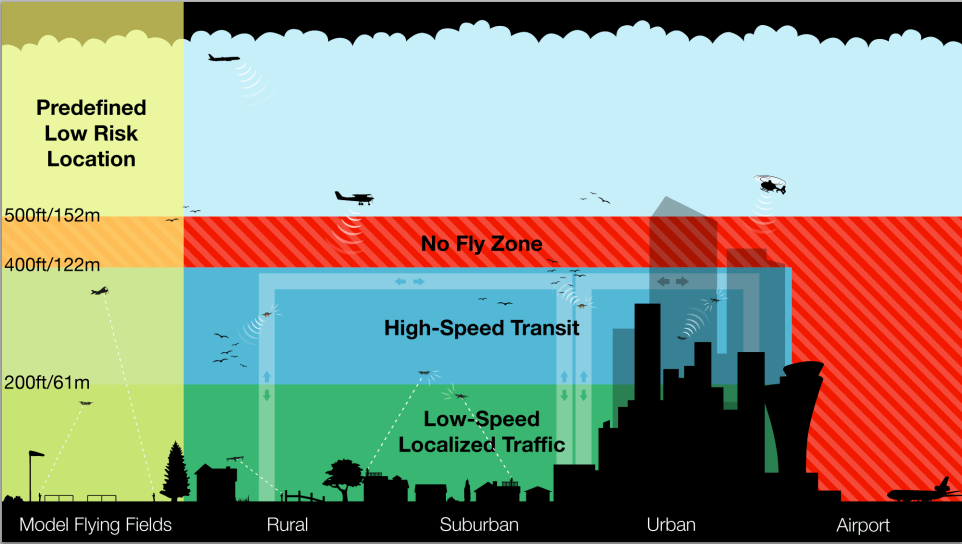 Amazon Prime Air’s Gur Kimchi addressed a packed house at AUVSI’s Xponential Conference in New Orleans today, as they promoted their concept for drone integration into the NAS.
Amazon Prime Air’s Gur Kimchi addressed a packed house at AUVSI’s Xponential Conference in New Orleans today, as they promoted their concept for drone integration into the NAS.
“Airspace is a shared resource – this is really important. Once you take off and fly, you are sharing the air,” says Kimchi. “What’s important is to have a model that is heterogeneous… that enables all applications.”
Amazon’s plan to integrate high- and low-altitude airspace is both simple in concept and ambitious in implementation. The company proposed an organized, layered structure of airspace combined with a system of “federated” traffic controllers to allow aircraft of all types to communicate with controllers and each other.
The plan, as pictured above, calls for different zones for different purposes – separating large aircraft, high speed transit drones, and low-speed, localized drone traffic by altitude; it calls for highly equipped drones with sense-and-avoid technology and communications, and well-trained, professional drone operators.
Saying that communication is critical, Kimchi explained Amazon’s proposed system of “federated traffic controllers.” The concept calls for multiple overlapping traffic channels: an individual drone will communicate with their local controller, controllers will communicate with each other. Local controllers will manage local airspace; federal regulators will have oversight and information over all controllers.
Kimchi says that this communications model already exists. “The technology is there,” he points out, saying that NASA is addressing a federated model with the multi-site test of UTM performed recently. The system seems to incorporate every possibility, including emergencies and unintended conflicts between drone flights; drones accidentally coming into range of one another will communicate and “de-conflict.”
While the proposal is easy to understand at a basic level, the scale is impressive. Amazon calls for global, interoperable protocols. “The only way this will work is by everyone speaking the same language… just like your cell phone, just like your laptop,” Kimchi says.
Cooperation between all stakeholders is critical for the success of the plan. He calls for both public and private industry to define and adopt standard for interoperability, and he says that it has to happen soon. “We have to be ready to keep scaling, and keep scaling safely,” he says. “…[Industry must] build systems and operations that are safe, secure and interoperable… from day one.”
When asked what it will take to prove that drones can be safely integrated to the public? “If you fly commercial and the weather is bad,there is a problem, and there is no visibility, who is really flying the plane? We trust automation every day in other ways – we have to prove that drones are just as safe…over time, we’ll get there.”

Miriam McNabb is the Editor-in-Chief of DRONELIFE and CEO of JobForDrones, a professional drone services marketplace, and a fascinated observer of the emerging drone industry and the regulatory environment for drones. Miriam has penned over 3,000 articles focused on the commercial drone space and is an international speaker and recognized figure in the industry. Miriam has a degree from the University of Chicago and over 20 years of experience in high tech sales and marketing for new technologies.
For drone industry consulting or writing, Email Miriam.
TWITTER:@spaldingbarker
Subscribe to DroneLife here.







[…] Amazon was one of the first to appear at drone industry events, explaining their concept of a federated airspace model for drone regulations in 2016, and investing heavily in government lobbying from 2014. […]